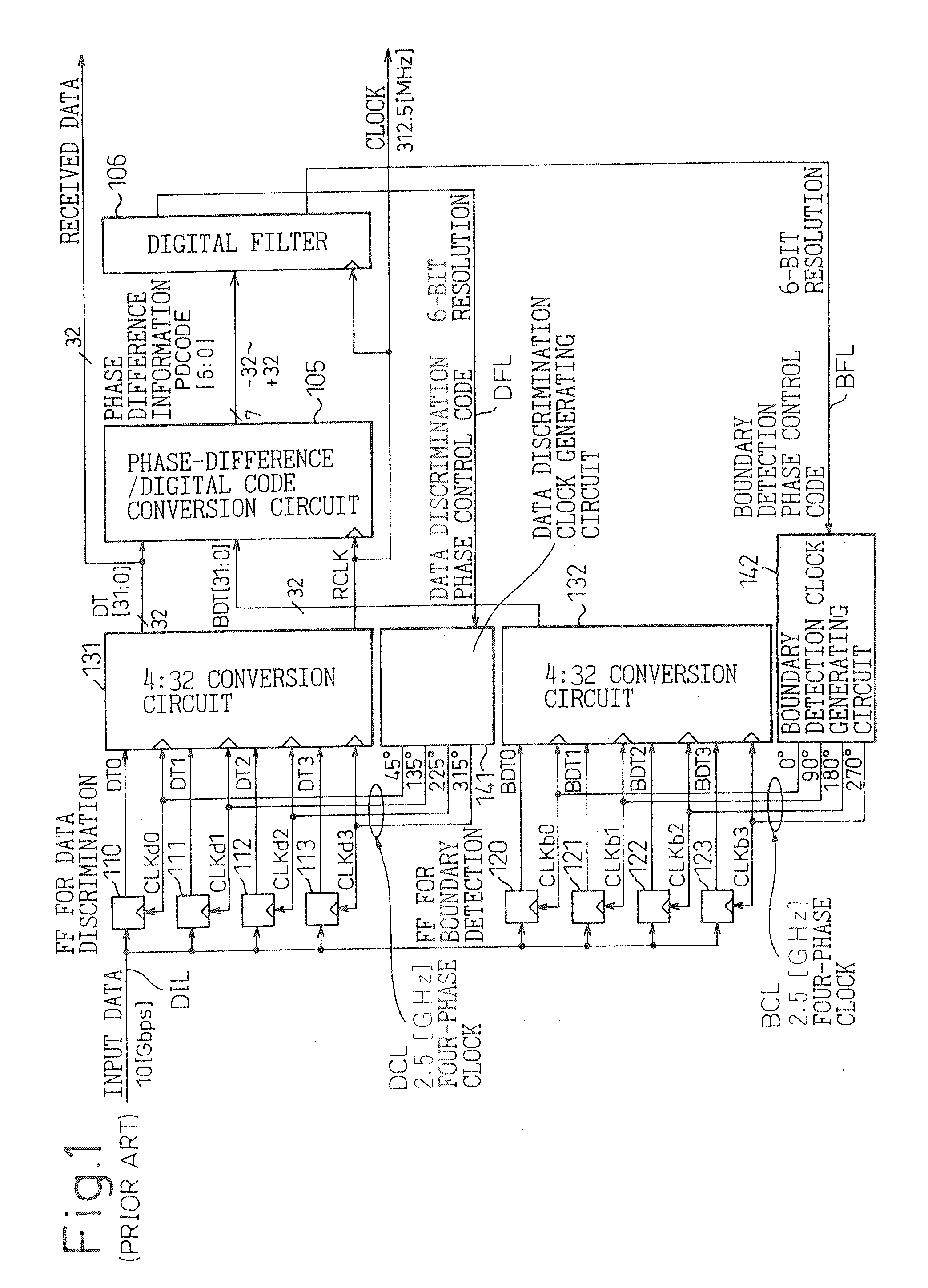Clock recovery circuit and data receiving circuit
a clock recovery and data processing technology, applied in the field of clock recovery circuits and data receiving circuits, can solve the problems of affecting the performance of the chip, the speed gap between the elements or circuit blocks of the chip becoming a major factor limiting the performance improvement of the computer as a whole, and the inability to improve the system performance further, so as to reduce the jitter dependence of feedback loop characteristics, improve the predictability of characteristics, and reduce the amplitude of the limit cycle signal
- Summary
- Abstract
- Description
- Claims
- Application Information
AI Technical Summary
Benefits of technology
Problems solved by technology
Method used
Image
Examples
first embodiment
[0189]FIGS. 30A and 30B are block diagrams showing the data receiving circuit according to the second mode of the present invention, wherein the circuit is configured as a 4-way×2 type interleaving circuit using CDR.
[0190]In FIGS. 30A and 30B, reference numerals 10 to 13 are data discrimination units (flip-flops for data discrimination, forming a data discrimination circuit), 20 to 23 are boundary detection units (flip-flops for boundary detection, forming a boundary detection circuit), 31 and 32 are data and boundary conversion circuits, respectively, 41 is a data discrimination clock generating circuit, 42 is a boundary detection clock generating circuit, 5 is a first phase-difference / digital-code conversion circuit, and 6 is a digital filter. Further, reference numeral 71 is a second phase-difference / digital-code conversion circuit, 72 is a first digital / analog converter (DAC), 73 is a second DAC, 74 is an adder, 75 is a voltage-controlled oscillator (VCO), and 76 is a buffer (cu...
second embodiment
[0218]FIGS. 38A and 38B are block diagrams showing the data receiving circuit according to the second mode of the present invention.
[0219]As is apparent from a comparison between FIGS. 38A, 38B and FIGS. 26A, 26B, the data receiving circuit of the second embodiment according to the second mode of the invention differs from the prior art configuration in that the digital filter 106 driven by the 312.5-MHz internal reference clock RCLK is replaced by two digital filters, i.e., the first digital filter 601 related to the first feedback loop (the low-frequency side feedback loop that provides the gain G1) and driven by a 312.5-MHz first internal reference clock RCLK-1, and the second digital filter 602 related to the second feedback loop (the high-frequency side feedback loop that provides the gain G2) and driven by a 625-MHz second internal reference clock RCLK-2.
[0220]The first digital filter 601 comprises a buffer 611 which provides gain G1 to the phase difference information PDCODE-...
third embodiment
[0232]FIGS. 42A and 42B are block diagrams showing the data receiving circuit according to the second mode of the present invention.
[0233]As is apparent from a comparison between FIGS. 42A, 42B and FIGS. 30A, 30B, 38A, and 38B, the data receiving circuit of the third embodiment according to the second mode of the invention is a combination of the data receiving circuit of the first embodiment according to the second mode of the invention and the data receiving circuit of the second embodiment according to the second mode. That is, as shown in FIGS. 42A and 42B, the data receiving circuit of the third embodiment according to the second mode of the invention is configured so that the output (here, PDCODE-2 [5:0]) of the second phase-difference / digital-code conversion circuit 71 in the data receiving circuit of the first embodiment shown in FIGS. 30A and 30B is supplied to the second digital filter 602 in the data receiving circuit of the second embodiment shown in FIGS. 38A and 38B. T...
PUM
 Login to View More
Login to View More Abstract
Description
Claims
Application Information
 Login to View More
Login to View More - R&D
- Intellectual Property
- Life Sciences
- Materials
- Tech Scout
- Unparalleled Data Quality
- Higher Quality Content
- 60% Fewer Hallucinations
Browse by: Latest US Patents, China's latest patents, Technical Efficacy Thesaurus, Application Domain, Technology Topic, Popular Technical Reports.
© 2025 PatSnap. All rights reserved.Legal|Privacy policy|Modern Slavery Act Transparency Statement|Sitemap|About US| Contact US: help@patsnap.com



